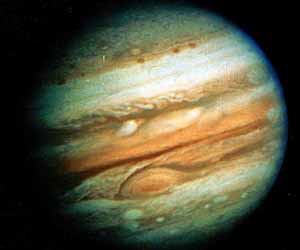|
|
Telescopes from Amazon
Planet Jupiter
Tweet
Planet Jupiter

Image taken by Voyager 1 on its approach to Jupiter in 1979
Jupiter's red spot

You could fit three Earths inside Jupiter's giant red spot
Planet Jupiter Facts
- Jupiter is the largest planet in the solar system. Its diameter is 88,846 miles (142,984 km), more than 11 times that of Earth, and about one-tenth that of the sun.
- It would take more than 1,000 Earths to fill up the volume of the giant planet.
- When viewed from Earth, Jupiter appears brighter than most stars. It is usually the second brightest planet after Venus.
- Jupiter is the fifth planet from the sun. Its average distance from the sun is about 484 million miles (779 million km), more than five times Earth's distance.
- Jupiter is a giant ball of gas and liquid with little, if any, solid surface.
- The red spot (left) is a giant storm which has raged for hundreds of years.
- Astronomers witnessed a spectacular event in July 1994, when 21 fragments of a comet named Shoemaker-Levy 9 crashed into Jupiter's atmosphere. The impacts caused tremendous explosions, some scattering debris over areas larger than the diameter of Earth.
Orbit, Atmosphere & Temperature
Orbit
Jupiter travels once around the Sun every 12 years and spins on its own axis every 10 hours compared to 24 on Earth, making it the fastest rotating planet in the Solar System.
Atmosphere
The atmosphere of Jupiter is composed of about 86 percent hydrogen, 14 percent helium, and tiny amounts of methane, ammonia, phosphine, water, acetylene, ethane, germanium, and carbon monoxide.
Temperature
The temperature at the top of Jupiter's clouds is around -145C (-230F). Deeper below the clouds the temperate reaches 21C (70F). Near the planet's center the temperature is hotter than the surface of the Sun!
Featured Telescope
Sponsored Links